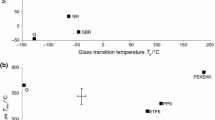Abstract
A versatile and flexible system is described for evolved gas analysis using a GLC, MS (mass scan and SIM modes) and GLC-MS. Gases evolved from materials in two differential thermal analysis units, a thermobalance or a micro-furnace linked directly to the MS or GLC can be analysed. Details are given of computer controlled data acquisition and processing. The techniques are applied to the thermal decomposition of calcium propanoate. Mechanisms are suggested to account for the observed decomposition products and the solid state process. Evidence is presented to support the view that the latter occurs via nucleation followed by two-dimensional growth with an activation energy of 315 kJ mol−1 and a pre-exponential factor of 4.8×1021s−1.
Zusammenfassung
Ein vielseitiges und flexibles System zur Analyse von gebildeten Gasen wird beschrieben, das GLC, MS (in Massen-scanning und SIM Betriebsweise) und GLC-MS umfaßt. Damit können die in zwei differentialthermoanalytischen Einheiten, einer Thermowaage oder einem direkt mit dem MS- oder GLC-Gerät gekoppelten Mikroofen aus den zu untersuchenden Substanzen entwickelten Gase analysiert werden. Einzelheiten der komputerkontrollierten Datengewinnung und Steuerung werden angegeben. Die Techniken werden zur Untersuchung der thermischen Zersetzung von Calciumpropionat herangezogen. Mechanismen werden vorgeschlagen, die die beobachteten Zersetzungsprodukte und die Festkörperreaktion erklären. Beweise werden dafür erbracht, daß bei letzterer eine Keimbildung und darauffolgendes zweidimensionales Wachstum vor sich geht, wobei die Aktivierungsenergie 315 kJ·mol−1 und der präexponentielle Faktor 4.8·1021·s−1 beträgt.
Резюме
Описана многосторон яя и гибкая система анализа выделяющего ся газа на основе использования газо-ж идкостной хроматогр афии (ГЖХ), масс-спектрометрии (MC) и совмещенного метода ГЖХ и MC. Термовес ы или микропечь соеди нены прямо с массспектрометром или газо-жидкостным х роматографом, что поз воляет анализировать газы, выделяющиеся из веще ств в этих двух различ ных термических аналити ческих блоках. Приведены детали сбо ра и обработки данных с помощью ЭВМ. Метод был использ ован для изучения термиче ского разложения про пионата кальция. Предложен ме ханизм реакций образования продукт ов разложения и тверд отельных процессов. Предсравл ены доказательства в пользу того, что твер дотельные процессы п роисходят через стадию образов ания центров кристаллиза ции, за которой следуе т двухразмерный рост с энергией активации 315 кдж.моль−1 и предэкшо ненциальным факторо м 4,8·1021 сек−1.
Similar content being viewed by others
References
S. B. Warrington andP. A. Barnes, Thermal Analysis Proc., Birkhauser Verlag, Basel, Boston, Stuttgart 1980, Vol. 1. p. 327.
A. B. Kiss, Acta Chim. Acad. Sci. Hung., 61 (1969) 207.
H. G. Weidemann, Thermal Analysis, Academic, New York, 1959, Vol. 1. p. 229.
H. G. Langer andR. S. Gohlke, Anal. Chem., 35 (1963) 1301.
H. G. Langer, R. S. Gohlke andD. H. Smith, Anal. Chem., 37 (1965) 433.
D. Price et al., Dyn. Mass Spectrometry, 5 (1978) 216.
J. W.Smith and D. R.Johnson, American Lab, Jan. (1981).
E. Baumgartner andE. Nachbaur, Thermochim. Acta, 19 (1977) 3.
T. L. Chang andT. E. Mead, Anal. Chem. 43 (1971) 534.
E. K. Gibson andS. M. Johnson, Thermochim. Acta, 4 (1972) 49.
P. A. Barnes, Reactivity of Solids, Plenum Press, New York, 1977, p. 663.
P. A. Barnes, G. Steñenson andS. B. Warrington, Proc. 2nd Europ. Symp. on Thermal Analysis, University of Aberdeen, Heyden and Son Ltd, London 1981, p. 47.
H. Limpricht, Ann., 108 (1858) 183.
J. P. Sichels andH. P. Schultz, J. Chem. Educ., 38 (1961) 300.
N. R. Chaudhuri, G. K. Pathak andS. Mitra, Indian J. Chem., 13 (1975) 689.
F. Charbonnier andE. Gobert-Ranchoux, J. Thermal Anal., 12 (1977) 33.
R. Hites andK. Biemann, J. Am. Chem. Soc., 9A (1972) 5772.
Author information
Authors and Affiliations
Additional information
The authors gratefully acknowledge the provision of an equipment grant and Research Studentships to G.S. and S.B.W. by the SERC.
Rights and permissions
About this article
Cite this article
Barnes, P.A., Stephenson, G. & Warrington, S.B. The use of TA — GLC — MS as a quantitative specific EGA technique for the investigation of complex thermal decomposition reactions: The thermal decomposition of calcium propanoate. Journal of Thermal Analysis 25, 299–311 (1982). https://doi.org/10.1007/BF01912955
Received:
Issue Date:
DOI: https://doi.org/10.1007/BF01912955




